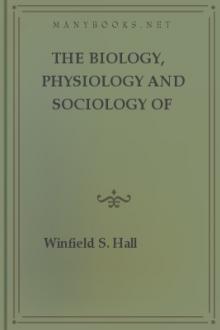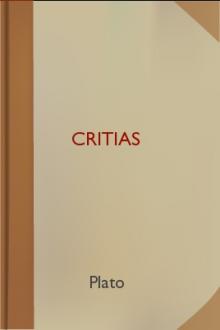Illusions, James Sully [speld decodable readers .TXT] 📗

- Author: James Sully
- Performer: -
Book online «Illusions, James Sully [speld decodable readers .TXT] 📗». Author James Sully
It appears at first as if the preliminary stages—the reception, discrimination, and classification of an impression—would not offer the slightest opening for error. This part of the mechanism of perception seems to work so regularly and so smoothly that one can hardly conceive a fault in the process. Nevertheless, a little consideration will show that even here all does not go on with unerring precision.
Let us suppose that the very first step is wanting—distinct attention to an impression. It is easy to see that this will favour illusion by leading to a confusion of the impression. Thus the timid man will more readily fall into the illusion of ghost-seeing than a cool-headed observant man, because he is less attentive to the actual impression of the moment. This inattention to the sense-impression will be found to be a great co-operating factor in the production of illusions.
But if the sensation is properly attended to, can there be error through a misapprehension of what is actually in the mind at the moment? To say that there can may sound paradoxical, and yet in a sense this is demonstrable. I do not mean that there is an observant mind behind and distinct from the sensation, and failing to observe it accurately through a kind of mental short-sightedness. What I mean is that the usual psychical effect of the incoming nervous process may to some extent be counteracted by a powerful reaction of the centres. In the course of our study of illusions, we shall learn that it is possible for the quality of an impression, as, for example, of a sensation of colour, to be appreciably modified when there is a strong tendency to regard it in one particular way.
Postponing the consideration of these, we may say that certain illusions appear clearly to take their start from an error in the process of classifying or identifying a present impression. On the physical side, we may say that the first stages of the nervous process, the due excitation of the sensory centre in accordance with the form of the incoming stimulation and the central reaction involved in the recognition of the sensation, are incomplete. These are so limited and comparatively unimportant a class, that it will be well to dispose of them at once.
Confusion of the Sense-Impression.
The most interesting case of such an error is where the impression is unfamiliar and novel in character. I have already remarked that in the mental life of the adult perfectly new sensations never occur. At the same time, comparatively novel impressions sometimes arise. Parts of the sensitive surface of the body which rarely undergo stimulation are sometimes acted on, and at other times they receive partially new modes of stimulation. In such cases it is plain that the process of classing the sensation or recognizing it is not completed. It is found that whenever this happens there is a tendency to exaggerate the intensity of the sensation. The very fact of unfamiliarity seems to give to the sensation a certain exciting character. As something new and strange, it for the instant slightly agitates and discomposes the mind. Being unable to classify it with its like, we naturally magnify its intensity, and so tend to ascribe it to a disproportionately large cause.
For instance, a light bandage worn about the body at a part usually free from pressure is liable to be conceived as a weighty mass. The odd sense of a big cavity in the mouth, which we experience just after the loss of a tooth, is probably another illustration of this principle. And a third example may also be supplied from the recollection of the dentist's patient, namely, the absurd imagination which he tends to form as to what is actually going on in his mouth when a tooth is being bored by a modern rotating drill. It may be found that the same principle helps to account for the exaggerated importance which we attach to the impressions of our dreams.
It is evident that all indistinct impressions are liable to be wrongly classed. Sensations answering to a given colour or form, are, when faint, easily confused with other sensations, and so an opening occurs for illusion. Thus, the impressions received from distant objects are frequently misinterpreted, and, as we shall see by-and-by, it is in this region of hazy impression that imagination is wont to play its most startling pranks.
It is to be observed that the illusions arising from wrong classification will be more frequent in the case of those senses where discrimination is low. Thus, it is much easier in a general way to confuse two sensations of smell than two sensations of colour. Hence the great source of such errors is to be found in that mass of obscure sensation which is connected with the organic processes, as digestion, respiration, etc., together with those varying tactual and motor feelings, which result from what is called the subjective stimulation of the tactual nerves, and from changes in the position and condition of the muscles. Lying commonly in what is known as the sub-conscious region of mind, undiscriminated, vague, and ill-defined, these sensations, when they come to be specially attended to, readily get misapprehended, and so lead to illusion, both in waking life and in sleep. I shall have occasion to illustrate this later on.
With these sensations, the result of stimulations coming from remote parts of the organism, may be classed the ocular impressions which we receive in indirect vision. When the eye is not fixed on an object, the impression, involving the activity of some-peripheral region of the retina, is comparatively indistinct. This will be much more the case when the object lies at a distance for which the eye is not at the time accommodated. And in these circumstances, when we happen to turn our attention to the impression, we easily misapprehend it, and so fall into illusion. Thus, it has been remarked by Sir David Brewster, in his Letters on Natural Magic (letter vii.), that when looking through a window at some object beyond, we easily suppose a fly on the window-pane to be a larger object, as a bird, at a greater distance.[15]
While these cases of a confusion or a wrong classification of the sensation are pretty well made out, there are other illusions or quasi-illusions respecting which it is doubtful whether they should be brought under this head. For example, it was found by Weber, that when the legs of a pair of compasses are at a certain small distance apart they will be felt as two by some parts of the tactual surface of the body, but only as one by other parts. How are we to regard this discrepancy? Must we say that in the latter case there are two sensations, only that, being so similar, they are confused one with another? There seems some reason for so doing, in the fact that, by a repeated exercise of attention to the experiment, they may afterwards be recognized as two.
We here come on the puzzling question, How much in the character of the sensation must be regarded as the necessary result of the particular mode of nervous stimulation at the moment, together with the laws of sensibility, and how much must be put down to the reaction of the mind in the shape of attention and discrimination? For our present purpose we may say that, whenever a deliberate effort of attention does not suffice to alter the character of a sensation, this may be pretty safely regarded as a net result of the nervous process, and any error arising may be referred to the later stages of the process of perception. Thus, for example, the taking of the two points of a pair of compasses for one, where the closest attention does not discover the error, is best regarded as arising, not from a confusion of the sense-impression, but from a wrong interpretation of a sensation, occasioned by an overlooking of the limits of local discriminative sensibility.
Misinterpretation of the Sense-Impression.
Enough has been said, perhaps, about those errors of perception which have their root in the initial process of sensation. We may now pass to the far more important class of illusions which are related to the later stages of perception, that is to say, the process of interpreting the sense-impression. Speaking generally, one may describe an illusion of perception as a misinterpretation. The wrong kind of interpretative mental image gets combined with the impression, or, if with Helmholtz we regard perception as a process of "unconscious inference," we may say that these illusions involve an unconscious fallacious conclusion. Or, looking at the physical side of the operation, it may be said that the central course taken by the nervous process does not correspond to the external relations of the moment.
As soon as we inspect these illusions of interpretation, we see that they fall into two divisions, according as they are connected with the process of suggestion, that is to say, the formation of the interpretative image so far as determined by links of association with the actual impression, or with an independent process of preperception as explained above. Thus, for example, we fall into the illusion of hearing two voices when our shout is echoed back, just because the second auditory impression irresistibly calls up the image of a second shouter. On the other hand, a man experiences the illusion of seeing spectres of familiar objects just after exciting his imagination over a ghost-story, because the mind is strongly predisposed to frame this kind of percept. The first class of illusions arises from without, the sense-impression being the starting-point, and the process of preperception being controlled by this. The second class arises rather from within, from an independent or spontaneous activity of the imagination. In the one case the mind is comparatively passive; in the other it is active, energetically reacting on the impression, and impatiently anticipating the result of the normal process of preperception. Hence I shall, for brevity's sake, commonly speak of them as Passive and Active Illusions.[16]
I may, perhaps, illustrate these two classes of illusion by the simile of an interpreter poring over an old manuscript. The first would be due to some peculiarity in the document misleading his judgment, the second to some caprice or preconceived notion in the interpreter's mind.
It is not difficult to define conjecturally the physiological conditions of these two large classes of illusion. On the physical side, an illusion of sense, like a just perception, is the result of a fusion of the nervous process answering to a sensation with a nervous process answering to a mental image. In the case of passive illusions, this fusion may be said to take place in consequence of some point of connection between the two. The existence of such a connection appears to be involved in the very fact of suggestion, and may be said to be the organic result of frequent conjunctions of the two parts of the nervous operation in our past history. In the case of active illusions, however, which spring rather from the independent energy of a particular mode of the imagination, this point of organic connection is not the only or even the main thing. In many cases, as we shall see, there is only a faint shade of resemblance between the present impression and the mental image with which it is overlaid. The illusions dependent on vivid, expectation thus answer much less to an objective conjunction of past experiences than to a capricious subjective conjunction of mental images. Here, then, the fusion of nervous processes must





Comments (0)